|
|
|
| My Favourite Planet > English > Europe > Greece > Macedonia > Pella |
| Pella, Greece |
Introduction to Pella |
 |
page 1 |
 |
|
| |

Restored Ionic columns of the north courtyard of the "House of Dionysos" at Pella Archaeological Site. |
| |
|
| |
The archaeological site of Pella, the ancient capital of Macedonia and birthplace of Alexander the Great, is located to the west of Pella village, just north of the EO2 National Road (E86 European route), 40 km northwest of the region's modern capital Thessaloniki.
Recent extensions to the site, the attractive restoration of many parts of the city and the opening of the new museum have made Pella an increasingly popular destination for tourists. However, it is rarely crowded and the atmosphere remains relaxed.
Modern Pella is a pleasant farming village with a petrol station, pharmacy, newspaper kiosk (periptero), bakery, a few shops, cafes and tavernas.
The town hall building (Dimarcheio) houses a doctor's surgery and a post office (Monday - Friday 7.30 am - 2 pm) which serves as a postbank, but there is no ATM (cash machine) in the village.
Pella's claim to fame is as the hometown of the Macedonian king Philip II and his son Alexander the Great.
Macedonia had been considered by other Greek states as a remote, semi-barbarous land until Philip, through his political and military skill, increased the power and wealth of his kingdom by conquering ever more territory until he ruled Greece.
The one-eyed king's triumphs allowed Alexander to fulfill his father's greater ambition of defeating the great Persian king and creating a Greek empire which stretched through Anatolia and the Levant to Egypt, and as far east as northwest India.
It is thought that Pella was made Macedonia's capital by King Archelaos at the end of the 5th century BC. The new city was built on the site of an ancient settlement on the shore of a lake connected by the navigable Ludias River to the Aegean Sea on the Thermaic Gulf. It prospered for about 250 years and attracted artists, architects and intellectuals from around the Greek world. |
|
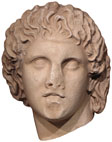
Alexander
the Great
Pella Museum |
|
| |
Pella lost its importance after 148 BC when the Romans made Thessaloniki the capital of their new province of Macedonia. The lake and river mouth silted up and eventually the city was abandoned.
A small village remained near the site which was first systematically explored by archaeologists in the 1950s. Since then excavations have continued to unearth more of the city, although much has yet to be discovered, including the theatre where Euripides staged his last plays, including the Bacchae, which received its first performance here around 408 BC. |
| |
See also the
Cheshire Cat Blog
photo essay about
the annual Full Moon Concert
at Pella Archaeological Site:
Full moon in Pella |
| |
| |
| |
| Pella |
Pella Archaeological Site and Museum |
|
 |
|
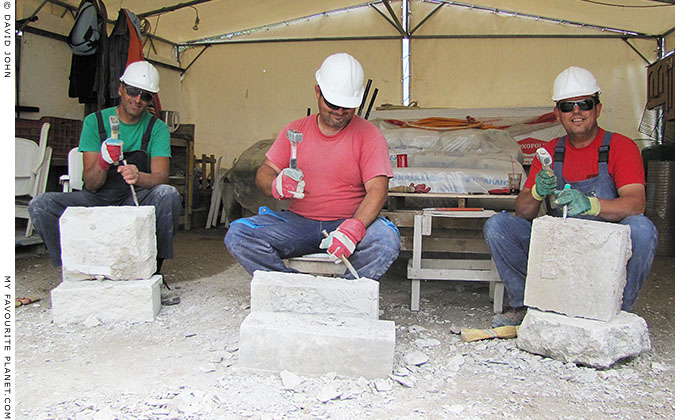
Local stonemasons at work during the restoration of the agora in the Pella Archaeological Site. |
| |
|
| |
For directions to the site and museum see How to get to Pella.
Pella Archaeological Site
The site lies amongst farmlands just southwest of the village of Pella. Archaeological excavations have continued here since 1957, and in recent years the main emphasis has been on restoring the excavated areas to make them accessible for visitors.
The land rises gently from the south end of the site, which in antiquity was the shore of a lake. Ancient workshops, including those for producing ceramics, have recently been unearthed here. At the south of the site are also the toilets, shop and workshops where copies of antiquities are made.
The centre of site is dominated by the remains of ancient houses which feature restored colonnades and exquisite mosaic floors (some of which are now in the museum). Further north, the city's agora (market place), with an area of 70,000 square metres, has recently been restored and opened to the public.
The foundations of the royal palace are above the agora, and a low hill just north of the museum is known as the acropolis. At the northeast edge of the village are the remains of the Thesmophorion (see photo below), the centre of the annual festival for the goddesses Demeter and Persephone. There are also a number of ancient Macedonian tombs around the site, although they are currently not open.
The EO2 National Road between Thessaloniki and Edessa roughly follows the course of the Roman Via Egnatia which passed through Pella. It is thought that this road was the city's main street. Unfortunately, this also meant that the busy, modern road passed through the middle of the site, making life for archaaeologists difficult. Recently a new stretch of road has built, bypassing the site. The old road now ends at the entrance to the site. |
|
|
|
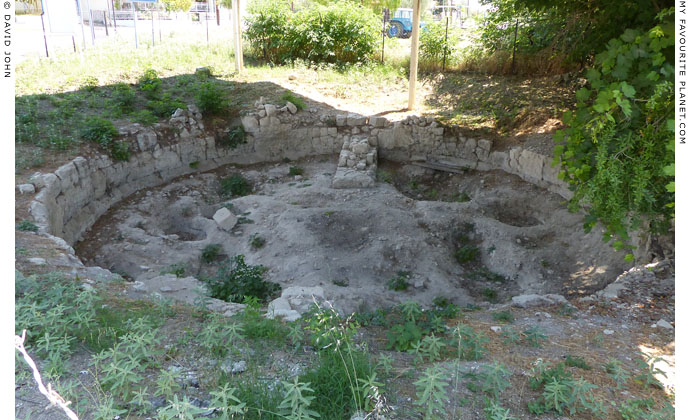
The remains of the Thesmophorion (Θεσμοφορίων) at the northeast of Pella village.
See the location on the Map of Pella on page 5.
For further information about the Thesmophorion of Pella and the Thesmophoria festival,
see Demeter and Persephone part 1 in the MFP People section. |
|
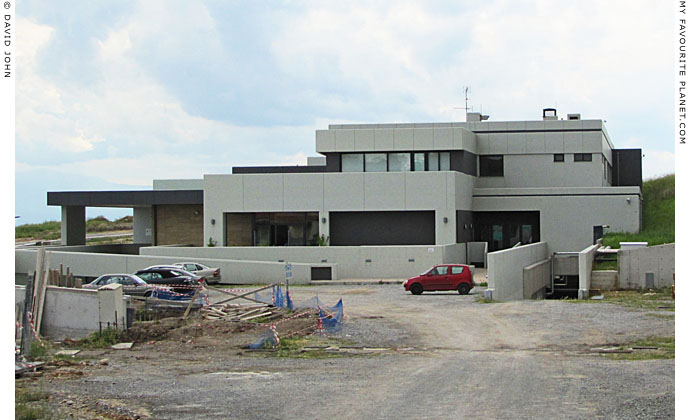
The New Archaeological Museum of Pella before completion of construction work on the forecourt.
A ramp leads from the forecourt to the main entrance. |
| |
The new Pella Archaeological Museum
The new museum, opened in March 2010, is to the west of the village. It replaces the tiny, old museum which was originally built as a pavilion for visitors to the archaeological site in the 1960s.
It is a spacious, modern building, allowing the latest display and lighting techniques, and providing more room for recent archaeological finds as well as informative elements such as models of ancient buildings. A corridor leads to a large, open-plan main exhibition room which is arranged in five themed sections:
1. daily life
2. public life
3. religion and cults
4. cemeteries
5. the palace
The exhibits include the famous marble head of Alexander the Great, large floor mosaics, coins, objects of stone, metal and ceramic, figurines, statuettes and inscriptions. The objects are labelled in Greek and English and there are several information boards which provide contexts the historical, geographical, social and religious aspects of the site.
There is also a lecture theatre in which multimedia presentations can be seen, and a terrace where you can sit and enjoy the drinks and snacks available at the snack bar.
At the southern end of the archaeological site there is a shop (open 8:00 - 15:00) selling copies of Greek antiquities, archaeological publications and souvenirs.
The site's permanent modern-day inhabitants are small, sand-coloured rodents of the squirrel family, similar to prairie-dogs, who live underground. Now and again you may see one pop its head out of a hole take a quick look around and disappear again.
I didn't manage to photograph one - they were just too fast for me. Archaeologist Haris Tsougaris, former Director of the Pella Museum, informs me that these critters are known as citellus citellus or spermopilus citellus. |
|
|
|

Road sign showing the way to Pella Archaeological Museum. |
| |
Pella Site and Museum times and tickets
Pella Archaeological Museum (Αρχαιολογικό Μουσείο Πέλλας)
Tel: (+30) 23820 32963
Website: www.pella-museum.gr (Greek only)
See also: odysseus.culture.gr/h/1/eh155.jsp?obj_id=3460
Greek Ministry of Culture and Sports website (Greek and English) with
details of opening times, tickets and reduced and free admission
(e.g. children under 18, students, senior citzens)
Ticket for museum and site: €6, reduced €3
There are toilets at the site and in the museum.
The museum has a café with drinks and snacks.
The visitor centre and shop at the south end of the archaeological site
sells books, souvenirs and copies of antiquities.
Both site and museum are accessible for wheelchair users.
Viewing the site and the museum each take 30-60 minutes.
The walk between the two takes around 10-15 minutes.
Pella village has shops, a bakery, a post office, cafes and restaurants.
Opening hours
All times and days apply to the museum and archeological site.
Last admission one hour before closing time.
Summer: Tuesday-Sunday 8:00 - 20:00
(Shop: 8:00 - 15:00)
Winter: Tuesday-Sunday 10:00 - 16:00
Monday closed (like most museums in Greece)
Public holidays
Open on the following public holidays:
Easter Saturday, Easter Monday
Good Friday open 12:00 until current closing time
15 August (Assumption of the Virgin Mary)
Closed on the following days:
1 January, 25 March, Easter Sunday, 1 May,
Christmas, 25 and 26 December
Election days
Open days (free admission)
6 March - in memory of Melina Mercouri
18 April - International Monuments Day
18 May - International Museums Day
5 June - World Environment Day
The last weekend of September (European Heritage Days)
28 October
Every first Sunday of the month 1 November - 1 March |
|
|
| |
| Pella |
Area map |
|
 |
|
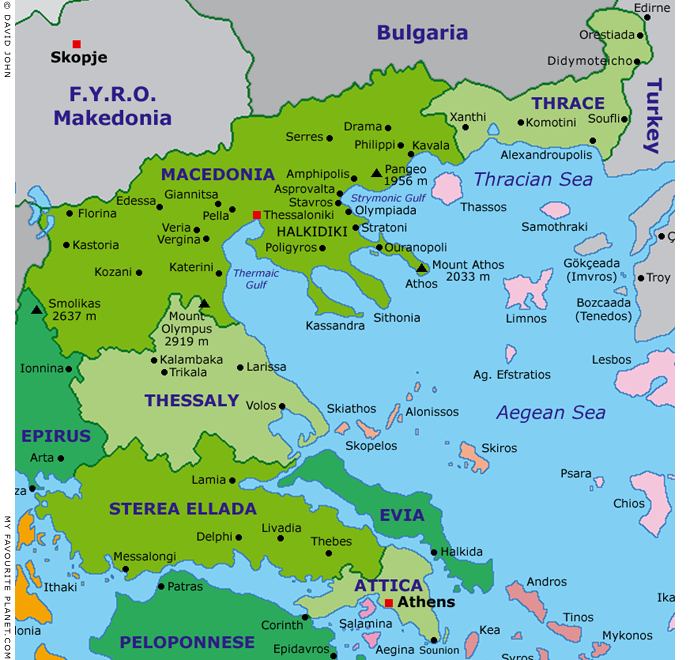
Interactive map of Macedonia, Thrace, Central Greece and the Aegean.
Colour key for Greek island groups (west-east)
See also our interactive map of Greece. |
Photos, maps and articles: copyright © David John,
except where otherwise specified.
Some of the information and photos in this guide to Pella
originally appeared in 2004 on davidjohnberlin.de.
All photos and articles are copyright protected.
Images and materials by other authors
have been attributed where applicable.
Please do not use these photos or articles without permission.
If you are interested in using any of the photos for your website,
project or publication, please get in contact.
Higher resolution versions are available on request.
My Favourite Planet makes great efforts to provide comprehensive and accurate information across this website. However, we can take no responsibility for inaccuracies or changes made by providers of services mentioned on these pages. |
|
| |
 |
Visit the My Favourite Planet Group on Facebook.
Join the group, write a message or comment,
post photos and videos, start a discussion... |
|
|
| |
|
|
|